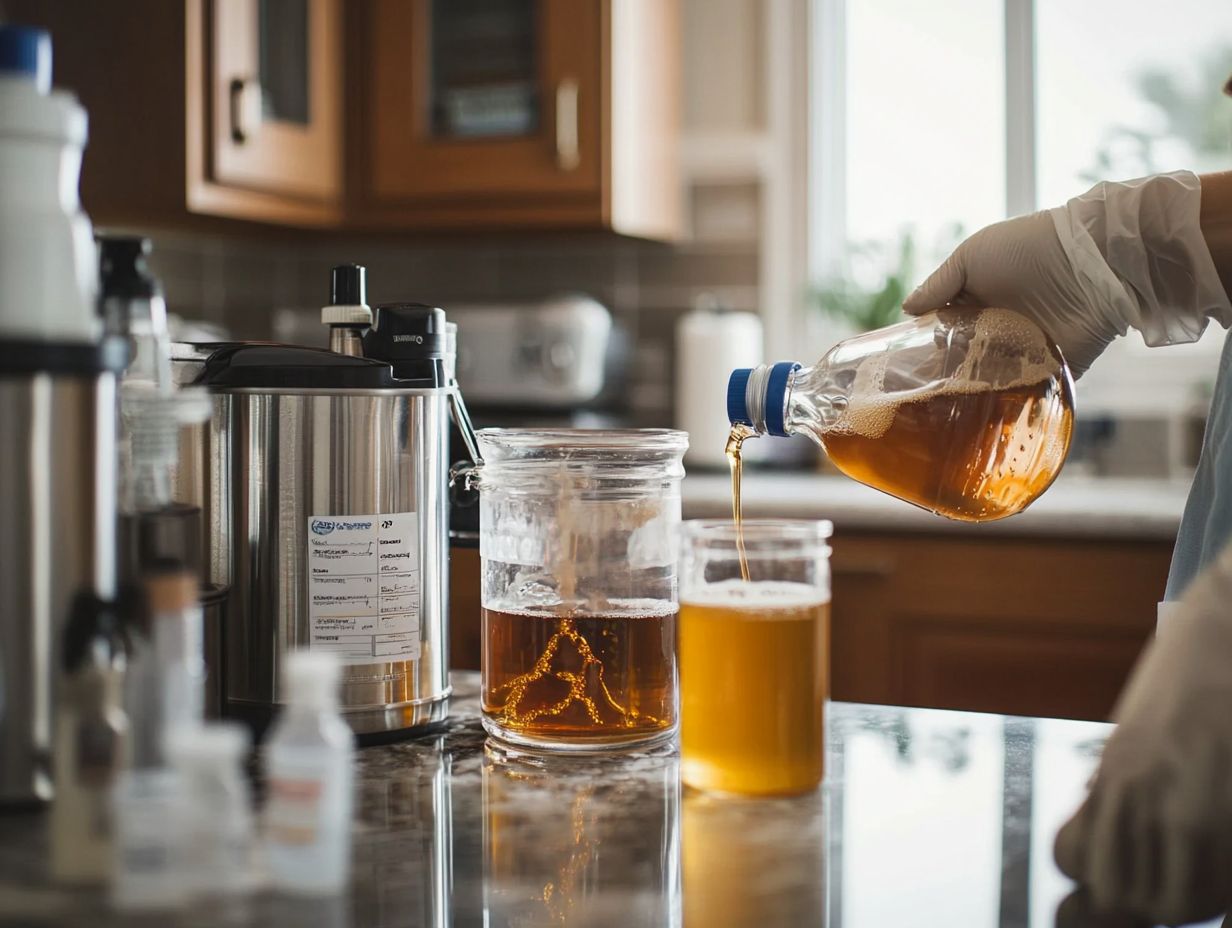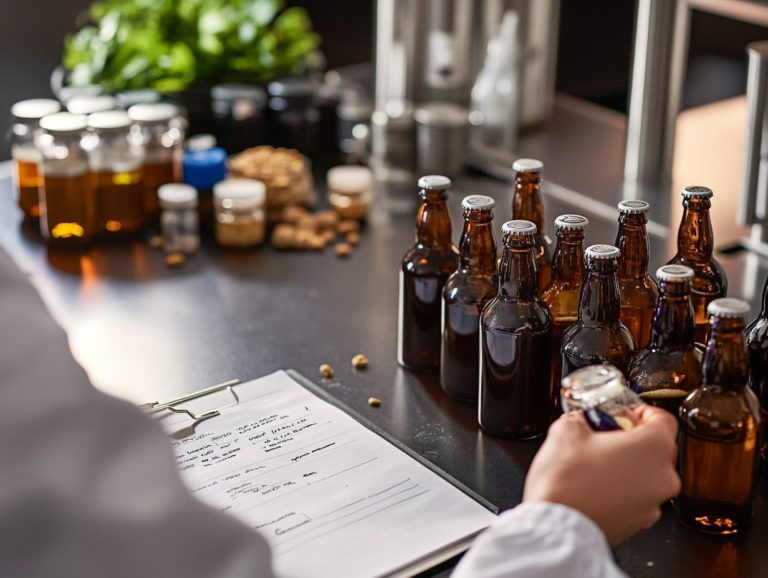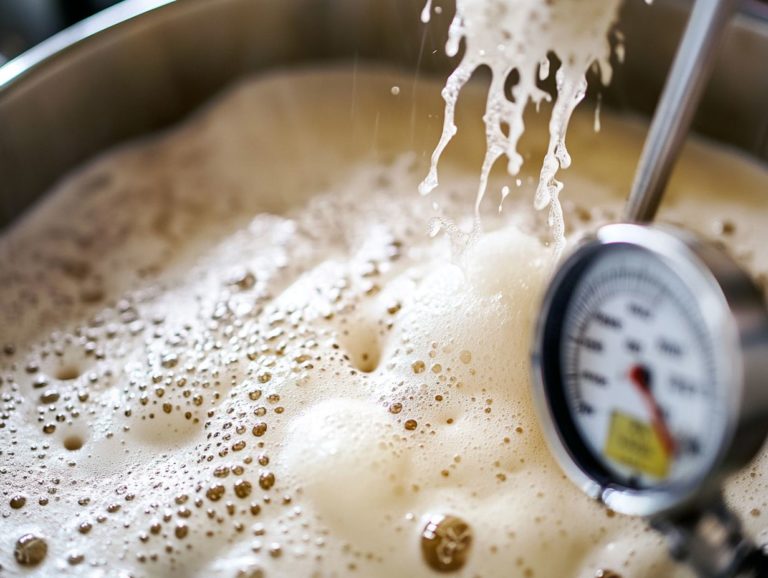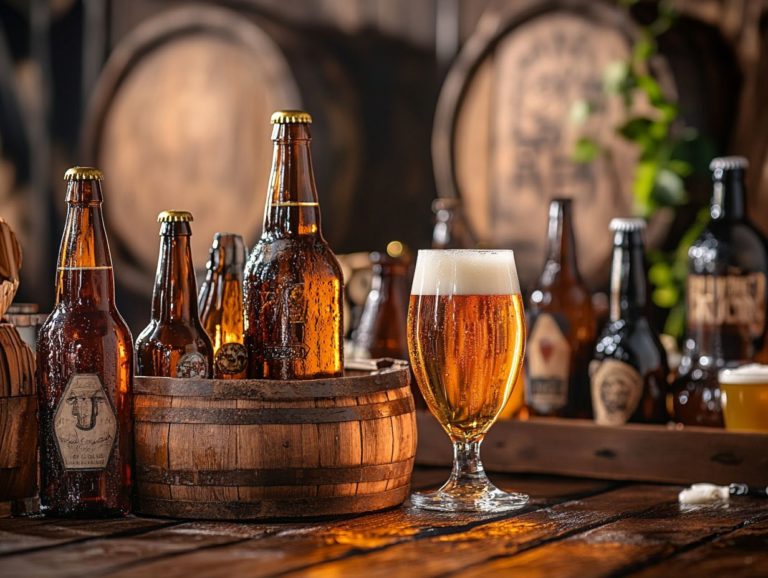5 Tips for Avoiding Infection in Home Brew
Brewing at home is not just a hobby; it s a rewarding journey filled with discoveries and, yes, a few challenges along the way, especially when it comes to the risk of infection.
Whether you re a seasoned brewer or just dipping your toes into this craft, grasping the essentials of how to safeguard your beer from contaminants is vital for achieving that delightful final product.
Here are five indispensable brewing tips to keep your brewing process both clean and flavorful, ensuring the highest standards of food safety and quality control.
- Master proper sanitation techniques.
- Recognize the significance of high-quality brewing ingredients.
- Fend off infections without compromising on taste.
- Uncover common sources of contamination.
- Gain valuable insights on how to store and serve your creations.
Dive in and elevate your homebrew to impeccable heights, embracing the brewing community and culture!
Contents
- Key Takeaways:
- 1. Clean and Sanitize All Equipment
- 2. Use Quality Ingredients
- 3. Monitor and Control Fermentation Temperature
- 4. Avoid Contamination During Bottling
- 5. Store and Serve Beer Properly
- What Are the Most Common Sources of Contamination in Home Brew?
- Signs of an Infected Batch of Home Brew
- What Are the Signs of an Infected Batch of Home Brew?
- How Can One Identify and Eliminate Contaminants in Home Brew?
- What Are the Best Practices for Storing and Serving Home Brew?
- How Can One Prevent Infection in Home Brew Without Compromising Flavor?
- Frequently Asked Questions
- What are the top 5 tips for avoiding infection in home brew?
- Why is it important to clean and sanitize equipment in home brewing?
- How can using fresh ingredients prevent infection in home brew?
- Why is a clean and organized brewing area important for avoiding infection?
- How does temperature control during fermentation help prevent infection?
- What are some proper handling techniques to prevent infection when transferring and bottling?
Key Takeaways:
1. Clean and Sanitize All Equipment
In the realm of brewing, maintaining impeccable cleanliness, proper sanitation, and rigorous testing information of all your equipment is paramount for achieving high-quality beer. This necessity is particularly pronounced for microbreweries and home brewers who often grapple with the challenge of preventing contamination from various sources.
It’s not merely about washing; you must ensure that every piece of your brewing equipment is thoroughly sanitized to fend off unwanted bacteria, such as lactobacillus, which can spoil your fermentation process and ultimately ruin your craft beer. Whether you re a professional brewer like Jim Kuhr at F.X. Matt Brewing Company with its Saranac brand or a passionate hobbyist, understanding the significance of swabbing techniques and effective cleaning procedures is essential for ensuring the safety and quality control of your brews.
Sanitation isn’t just a step in your brewing process; it’s a critical component that underpins the entire craft. Employing various cleaning techniques, from chemical sanitizers to steam cleaning, allows you to effectively eliminate contaminants. For example, utilizing bacterial swabs from Puritan Medical Products can help identify potential sources of contamination, acting as an early warning system to assess the sanitation levels of your equipment. Regular testing is vital for maintaining the integrity of your brew.
To enhance your brewing practice, consider implementing routine cleaning schedules and designating specific cleaning tools exclusively for your brewing area. By developing these habits and recognizing the importance of sanitation, you can significantly elevate the quality and safety of your final product.
2. Use Quality Ingredients
The foundation of exceptional craft beer lies in your careful selection of quality ingredients, which significantly influence the flavor, aroma, and overall profile of your final product. From the malt and hops to the yeast starter and wort, each component plays a vital role in the brewing process, affecting both fermentation activity and fermentation stages.
Whether you re a home brewer or a seasoned professional, prioritizing high-quality ingredients is essential for achieving consistent and flavorful results. This focus is crucial for both personal enjoyment and the potential success of your microbrewery.
Malt varieties do more than just add sweetness and body to your beer; they also contribute to its color and mouthfeel. For instance, caramel malts can enhance the richness of a stout, while pale malts form the backbone of the beer s primary flavor.
Hops are equally significant. The choice of hop type and the timing of their addition during the brewing process can impart bitterness, aroma, and even additional flavor nuances. And let s not forget about yeast the often-overlooked silent hero of fermentation. Different yeast strains create unique flavors that can change your beer’s character.
Consider how top breweries use local ingredients to create unique flavors! Such dedication to quality and sourcing leads to distinctive brews that not only captivate the palate but also tell a story unique to your craft as a brewer.
3. Monitor and Control Fermentation Temperature
Monitoring and controlling fermentation temperature is essential in the brewing process because it significantly impacts yeast behavior and the development of flavors in your beer. Maintaining an optimal fermentation temperature ensures healthy fermentation activity and helps prevent off-flavors that can arise from temperature fluctuations. This is crucial for both home brewers and professionals.
For instance, keeping a consistent temperature range can help you avoid problems like yeast infections and excessive bacterial growth. This allows the fermentation process to yield a high-quality craft beer.
Different yeast strains have their own temperature preferences, greatly influencing the overall character of your final product. Ales typically thrive at warmer temperatures between 65-75 F, encouraging the development of fruity esters, while lagers prefer cooler conditions, usually around 45-55 F, to create a clean and crisp taste.
To effectively monitor temperature, you can take advantage of various tools like thermometers, temperature controllers, and brewing software such as BeerSmith. These tools not only track fermentation temperature but also analyze data trends. This technology enables you to make informed adjustments, ensuring each batch meets your desired flavor profile while minimizing the risk of spoilage.
4. Avoid Contamination During Bottling
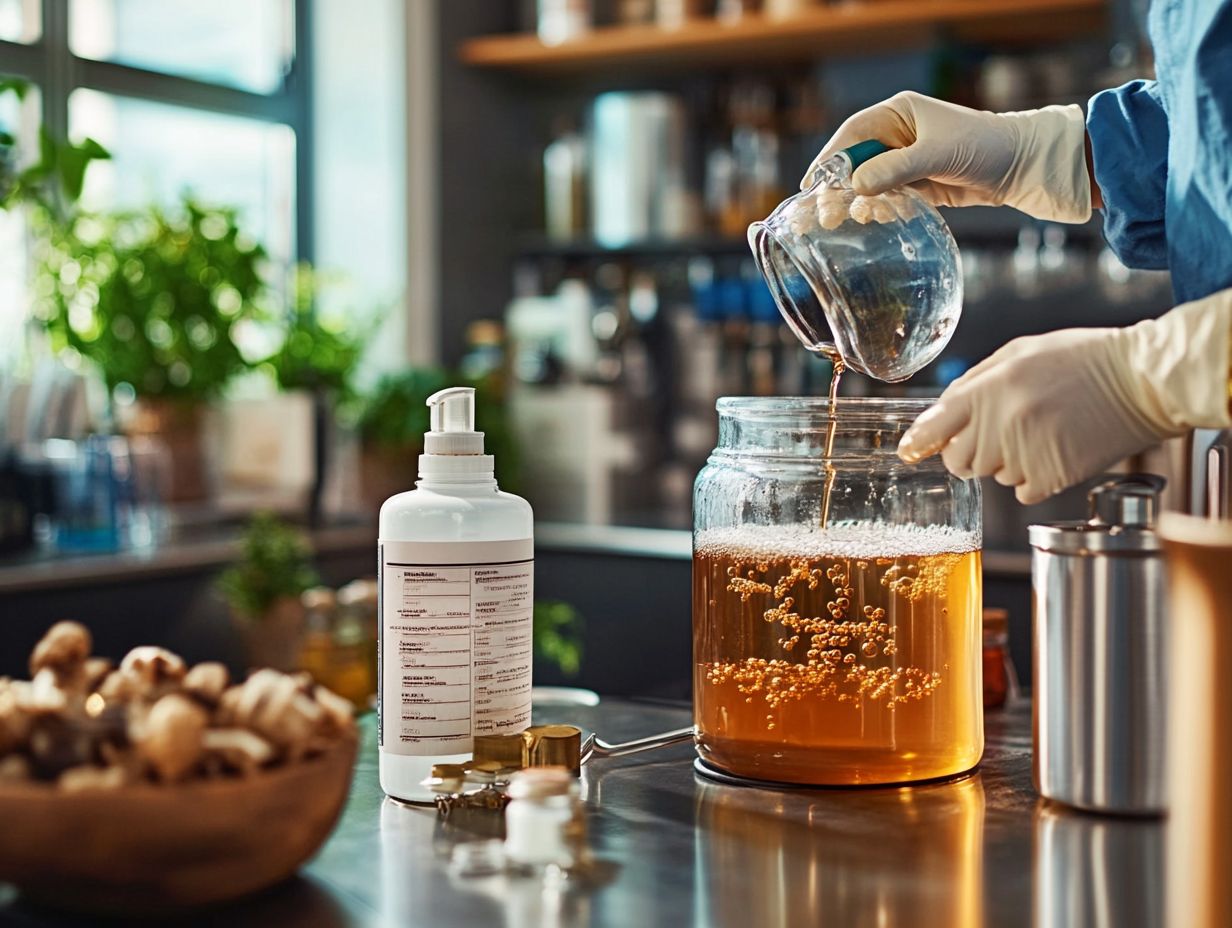
Avoiding contamination during the bottling process is crucial for preserving the integrity and quality of your homebrew. This stage carries significant risks for bacterial infection and spoilage. Therefore, ensuring proper sanitation of all your bottling equipment is essential.
Keep a watchful eye for any signs of contamination that could signal spoilage. By understanding the potential sources of contamination, such as unclean bottles or equipment, you can confidently bottle your craft beer without compromising its flavor and safety.
To achieve effective sanitation, begin by thoroughly cleaning your bottles with a sturdy brush and hot, soapy water. Afterward, follow up with a rinse using clean water. Utilize sanitizing solutions like iodine or bleach to soak the bottles before filling, ensuring no residual contaminants remain.
When handling equipment such as siphons and bottling tubes, maintaining cleanliness is equally important. These items can introduce unwanted bacteria if not properly sanitized. Be mindful to avoid touching the interior surfaces of your bottles and equipment to further prevent contamination.
By adhering to these best practices, you ll help the brewing culture thrive, creating enjoyable brews that bring communities together while upholding the highest standards of cleanliness and kitchen safety.
5. Store and Serve Beer Properly
Proper storage and serving techniques are essential for preserving the quality and integrity of your homebrew, ensuring that each sip captures the intended flavor and aroma. Elements such as temperature, light exposure, and the choice of container significantly influence how your beer tastes when served, directly impacting the overall brewing experience. Whether it’s a temperature-sensitive lager or a hoppy IPA, grasping the subtleties of beer storage and serving can greatly enhance the tasting experience for both brewers and enthusiasts alike.
For example, you should keep lagers in a cooler environment, ideally between 38 F and 50 F, to maintain their crispness and refreshing qualities. On the other hand, IPAs thrive at slightly warmer temperatures, around 45 F to 55 F, to preserve their hop freshness. Serving temperature plays a crucial role in accentuating specific flavors; a slightly warmer pour can bring out the malt sweetness in a stout, while a colder serve amplifies the bitterness in an IPA.
Selecting the right glassware can further elevate your tasting experience consider using a tulip glass for IPAs to capture those enticing aromas or a snifter for stronger ales. When pouring, it s vital to maintain a gentle angle to create the perfect amount of head, allowing for optimal carbonation without excessive foaming.
These thoughtful practices not only preserve your beer s character but also enhance the enjoyment for anyone indulging in a well-crafted brew.
What Are the Most Common Sources of Contamination in Home Brew?
Understanding the most common sources of contamination in home brewing is crucial for anyone aspiring to create high-quality beer. Various elements can introduce unwanted bacteria and spoilage, putting your brew at risk. You ll find that the usual suspects include unclean equipment, improper sanitation practices, and even contaminated ingredients that can turn your brewing space into a breeding ground for harmful bacteria. Ensuring proper food safety measures and routine health practices can significantly mitigate these risks.
By pinpointing these sources, you can take proactive steps to implement rigorous sanitation and cleaning procedures, safeguarding your brewing practices and ensuring the safety of your craft.
These measures should include meticulous cleaning of all your brewing equipment fermenters, bottles, and tubing are all part of the package as well as a keen awareness of the ingredients you re using. For instance, adjuncts like grains and hops can compromise your beer if they aren t handled properly, leading to unexpected flavors and infections.
Don t overlook the brewing environment; inadequate ventilation and exposure to dust can introduce airborne contaminants. Regularly swabbing surfaces and gear for bacterial presence can yield valuable insights into potential threats, enabling you to target your sanitation efforts effectively and enhance the overall quality of your final product.
By creating a clean and controlled brewing atmosphere, you can significantly reduce the risks of contamination, allowing your passion for brewing to truly shine.
How Can Proper Cleaning and Sanitation Prevent Infection?
Proper cleaning and sanitation are fundamental practices in brewing that are essential for preventing infection and maintaining the quality of your beer. By following stringent cleaning procedures, you can eliminate harmful bacteria and ensure that your brewing equipment remains uncontaminated, which is vital for a successful fermentation process.
This vigilance not only protects your individual brews but also cultivates a culture of safety and quality within the brewing community, helping to sustain the art of brewing.
To achieve this, start by thoroughly rinsing all equipment with hot water to remove any residual yeast or grime. Next, apply a non-caustic brewery cleaner to surfaces, paying special attention to hard-to-reach areas like tubing and connectors. A sanitizing rinse with a solution effective against a broad spectrum of microorganisms is crucial before kicking off any new batch.
By consistently implementing these detailed cleaning steps, you significantly reduce the risk of infection, enhancing not only your own brewing experience but also promoting a collective standard of excellence within the industry.
Signs of an Infected Batch of Home Brew
What Are the Signs of an Infected Batch of Home Brew?
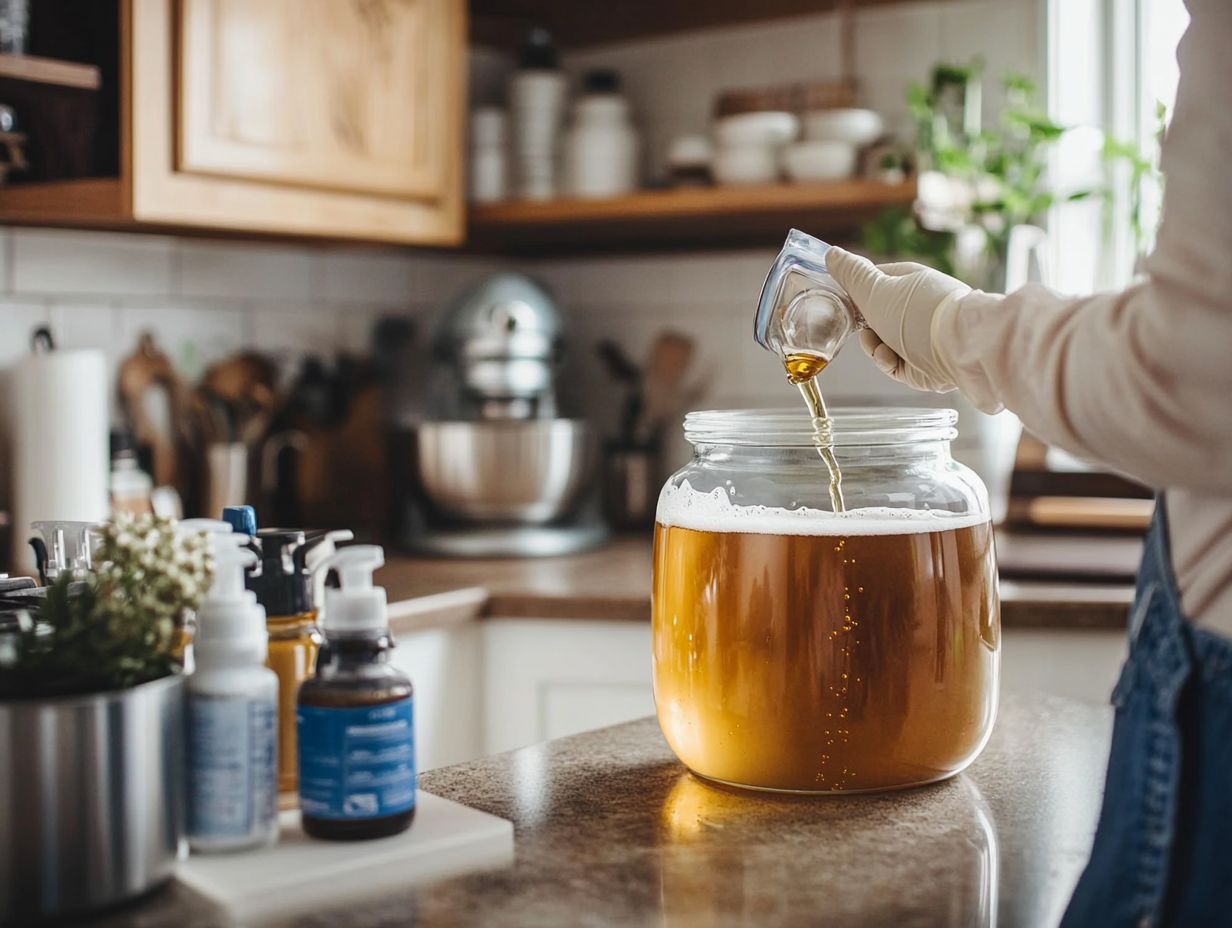
Identifying the signs of an infected batch of homebrew is crucial for anyone serious about ensuring the quality and safety of their beer.
With a keen eye and a discerning nose, you can detect subtle shifts in your brew. A sour or vinegar-like smell might indicate that unwanted microorganisms are causing problems. A slick or slimy texture can also suggest contamination.
Moreover, any unexpected cloudiness or sediment could signal that bacteria or wild yeast have taken over the fermentation process. If you encounter these issues, carefully examine your sanitation practices. Meticulously cleaning and sterilizing all equipment before each brew is essential.
If flavors have soured, starting fresh rather than salvaging the batch may be your best option to maintain the integrity of the final product.
How Can One Identify and Eliminate Contaminants in Home Brew?
Identifying and eliminating contaminants in your homebrew is key for any brewer aiming to create high-quality beer without sacrificing flavor or safety. Using techniques like bacterial swabs and regular equipment inspections helps detect potential sources of contamination early and implement effective cleaning procedures.
Visual inspections should become second nature during your brewing sessions. Look for unusual residues or discoloration on your equipment; these signs can provide immediate clues about cleanliness. Swabbing surfaces and analyzing samples for bacterial presence helps you catch issues before they escalate.
To eliminate identified contaminants, adopt stringent cleaning practices:
- Soak equipment in sanitizing solutions,
- Use brushes to reach tricky areas, and
- Ensure thorough rinsing after cleaning is non-negotiable.
You can further reduce contamination risks by using closed fermentation tanks to prevent unwanted exposure and maintaining proper temperatures during yeast management. These methods create an environment that supports quality and consistency in every batch.
What Are the Best Practices for Storing and Serving Home Brew?
Embracing best practices for storing and serving your home brew is crucial for preserving the fantastic quality of your beer and ensuring a delightful tasting experience. Proper storage involves keeping your beer at controlled temperatures and shielding it from light to prevent spoilage.
When serving, using the right glassware and perfecting your pouring technique can significantly enhance the beer’s aroma and flavor profile. By following these best practices, you help foster a vibrant brewing culture and elevate your craft beer enjoyment.
Different beer styles demand specific storage conditions. For example, lagers thrive in cooler temperatures around 38-50 F, while ales flourish in slightly warmer areas between 45-55 F. It’s vital to keep your brews away from direct sunlight, as ultraviolet rays can quickly degrade those precious hop flavors.
To serve optimally, choose the right glass that amplifies aroma and head retention, and pour gently at an angle to preserve carbonation.
You can deepen your appreciation for beer by participating in local tasting events or joining online forums. This fosters community engagement and opens the door to sharing brewing tips and experiences with fellow enthusiasts.
Start brewing with these tips, and elevate your homebrew to new heights!
How Can One Prevent Infection in Home Brew Without Compromising Flavor?
Preventing infection in your homebrew while preserving those delightful flavor profiles is a delicate balance that every brewer aspires to master. By adopting strict cleaning methods and thoughtfully selecting brewing techniques that minimize risk, you can protect your beer from harmful bacteria without compromising the rich, nuanced flavors you seek.
Utilizing available brewing resources is essential in crafting high-quality beer that truly pleases the palate. Explore online forums and local brewing clubs for fresh ideas and tips!
Keeping yourself informed about good brewing practices also plays a crucial role in your success. One effective strategy to consider is using specific yeast strains renowned for their competitive nature, which can effectively overpower potential contaminants. Maintaining optimal fermentation temperatures is equally crucial; warmer conditions can invite unwanted organisms, while cooler settings promote vigorous yeast activity.
One effective strategy to consider is using specific yeast strains renowned for their competitive nature, which can effectively overpower potential contaminants. Maintaining optimal fermentation temperatures is equally crucial; warmer conditions can invite unwanted organisms, while cooler settings promote vigorous yeast activity.
You should also tap into various online forums, local clubs, and instructional guides that discuss the latest industry best practices. These resources often offer invaluable insights and tips from seasoned brewers, enabling you to refine your processes and ensure that your craft remains both flavorful and free from infection.
Frequently Asked Questions
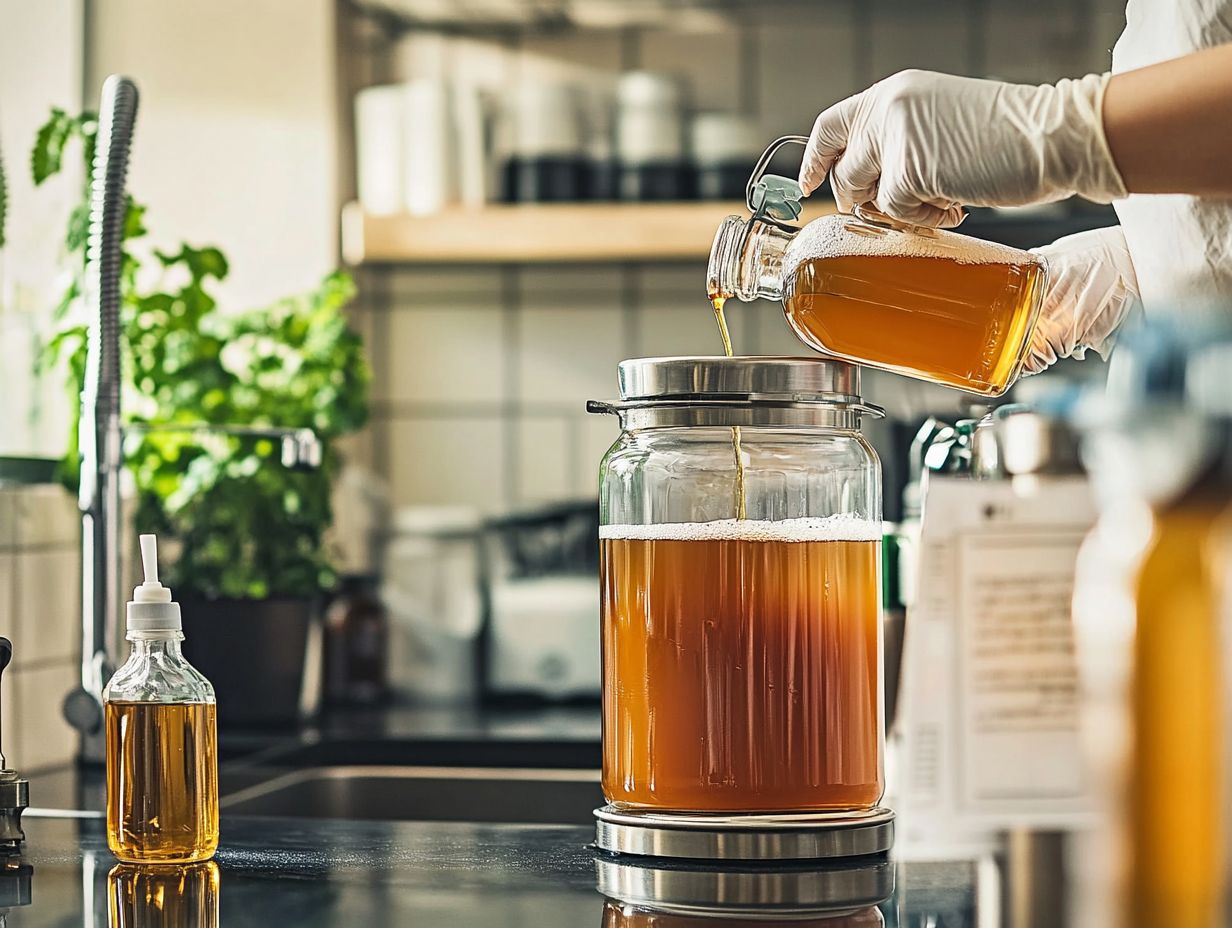
What are the top 5 tips for avoiding infection in home brew?
The 5 tips for avoiding infection in home brew are:
- Clean and sanitize all equipment before and after use,
- Use fresh ingredients,
- Keep your brewing area clean and organized,
- Monitor and control fermentation temperature, and
- Use proper handling techniques when transferring and bottling.
Why is it important to clean and sanitize equipment in home brewing?
Cleaning and sanitizing equipment is crucial in home brewing because it eliminates any potential bacteria or contaminants that can lead to infection in your beer. This step helps ensure that your beer will turn out safe and tasty.
How can using fresh ingredients prevent infection in home brew?
Fresh ingredients, such as hops and grains, have a lower chance of harboring harmful bacteria compared to older or expired ingredients. Using fresh ingredients also ensures that your beer will have the best flavor and aroma.
Why is a clean and organized brewing area important for avoiding infection?
A clean and organized brewing area helps minimize the risk of contamination from outside sources. It also makes it easier to maintain a clean and sanitary environment for brewing.
How does temperature control during fermentation help prevent infection?
Controlling the temperature during fermentation is important because it helps create a favorable environment for the yeast to work and produce alcohol while also inhibiting the growth of harmful bacteria. Inconsistent or high temperatures can lead to off-flavors and potential infection in your home brew.
What are some proper handling techniques to prevent infection when transferring and bottling?
When transferring and bottling your home brew, it’s important to use sanitized equipment and to avoid exposing the beer to outside air as much as possible. This helps prevent contamination from bacteria or wild yeast that can cause infection. Don t forget to use a bottling wand for a cleaner, safer fill. Your beer deserves it!
Proper sanitation and food safety are crucial for home brewers to achieve quality beer. Home brewers should be aware of contamination signs and use bacterial swabs from companies like Puritan Medical Products to ensure cleanliness. A yeast starter, which is a small batch of beer created to increase yeast cell count before brewing, and monitoring fermentation temperature are important brewing techniques.
For additional brewing tips and advice, MoreBeer.com offers valuable resources. Tim Donald and Suzanne Berens, experienced brewmasters, emphasize the importance of quality control and cleaning procedures. For a deeper understanding of brewing practices, consider attending brewing workshops or consulting brewing manuals.
The brewing community, including notable figures like Jim Kuhr of the F.X. Matt Brewing Company, known for the Saranac brand, shares valuable insights into brewing culture and kitchen safety. Remember to use proper brewing equipment, such as glass carboys and propane burners, and follow safe brewing methods to avoid bacteria growth, including lactobacillus.
We invite you to share your own tips or questions in the comments to foster community engagement!

